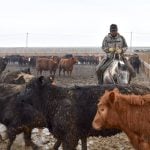The near-total adoption of reduced tillage management systems in many areas of the country is having a liberating effect on the emergence of a weed spectrum suited to this new ecology.
There are some pesky weeds out there that germinate in fall stubble and can be difficult to control in the spring. Modern low-tillage systems mean greater winter survival for these cagey fall annual weeds, so they get out of the gate sooner and are well established before the spring burnoff.
“It’s the guys with spring crops that are getting caught,” says Manitoba Agriculture weed specialist Bruce Murray. “They aren’t seeding in the fall so they aren’t thinking of that field after they’ve harvested it and they aren’t likely to be out walking those fields and scouting for weeds in the fall.”
Read Also

Producers aren’t panicking over tariffs and trade threats
The Manitoba Canola Growers Association (MCGA) surveyed its members this spring to get a sense of how trade uncertainty was…
Fall annual weeds take advantage of the same principle that makes winter cereals work. These weeds get a head start on spring species by germinating more than a half year earlier. The snow provides an insulating blanket that protects their seedlings from the harsh cold, and they spend the winter in a state of dormancy. When the snow melts a robust, fully formed plant takes off and out-competes the spring annuals that haven’t even emerged yet.
“What we have changed is the tillage system, so there’s more opportunity for winter annual weeds to be successful,” says Murray. “Without fall tilling, we have stubble so we’re getting pretty good snow cover and the weeds are able to survive.”
Two of the nastiest invaders are related grasses — downy brome (sometimes called cheat grass or military grass) and Japanese brome. Both are relatively new to the Canadian Prairies and both have shown themselves to be very competitive as fall annual weeds.
“They’re very aggressive… be afraid of these two,” Murray says. “We’ve had Japanese brome in a rye field in Treherne, Manitoba and I have never seen rye get so badly out-competed. It never had a chance.”
There are two reasons why these grasses are such formidable competitors. First, they propagate by seeds and, like most annual grasses, they make plenty of them. Plus, those seeds can remain dormant for upwards of five years. On top of that they have the advantage of going undetected if producers aren’t scouting their fields in the fall.
Japanese brome was introduced as a forage species and has spread over large parts of North America, especially in the Great Plains region. Like Downy brome, it’s an aggressive competitor for moisture and nutrients and also has the advantage of an early start in the spring.
It matures in late May or early June and stands 14 to 40 inches in height. It too has the drooping panicles and it sets seed when other plants are maturing. The seeds of Japanese brome are long lived, remaining viable for several years.
Control of these grasses is not easy, especially in fall seeded winter annual crops such as winter wheat or fall rye. Both of these grasses should be treated as soon as you find them because, once established, they are very difficult to eradicate.
The number one control option is to stop growing these winter annual crops for while — at least three to five years, Murray says.
“Even though glyphosate will kill lots of them, you still can’t go and use a Roundup Ready crop for one year and then go into a fall rye,” Murray says. “That seed bank is loaded and they have their perfect growing conditions sneaking into a winter annual crop. It matches up beautifully.”
The best control options so far are spring tillage and glyphosate burnoff while keeping in mind that it’s still possible to see it for the next three to five springs.
If these bromes are trouble in crop fields, however, they can be even worse in pastures or range land.














